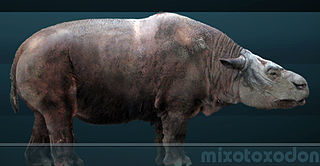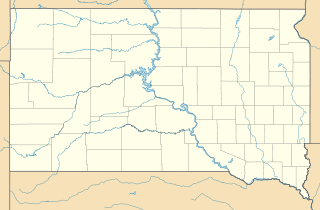
A mammoth is any species of the extinct genus Mammuthus, one of the many genera that make up the order of trunked mammals called proboscideans. The various species of mammoth were commonly equipped with long, curved tusks and, in northern species, a covering of long hair. They lived from the Pliocene epoch into the Holocene at about 4,000 years ago, and various species existed in Africa, Europe, Asia, and North America. They were members of the family Elephantidae, which also contains the two genera of modern elephants and their ancestors.

Popocatépetl is an active stratovolcano, located in the states of Puebla and Morelos, in central Mexico, and lies in the eastern half of the Trans-Mexican volcanic belt. At 5,426 m (17,802 ft) it is the second highest peak in Mexico, after Citlaltépetl at 5,636 m (18,491 ft).

Mastodons are any species of extinct proboscideans in the genus Mammut, distantly related to elephants, that inhabited North and Central America during the late Miocene or late Pliocene up to their extinction at the end of the Pleistocene 10,000 to 11,000 years ago. Mastodons lived in herds and were predominantly forest-dwelling animals that fed on a mixed diet obtained by browsing and grazing with a seasonal preference for browsing, similar to living elephants.

The Columbian mammoth is an extinct species of mammoth that inhabited North America as far north as the northern United States and as far south as Costa Rica during the Pleistocene epoch. It was one of the last in a line of mammoth species, beginning with Mammuthus subplanifrons in the early Pliocene. The Columbian mammoth evolved from the steppe mammoth, which entered North America from Asia about 1.5 million years ago. The pygmy mammoths of the Channel Islands of California evolved from Columbian mammoths. The closest extant relative of the Columbian and other mammoths is the Asian elephant.

Nevado de Toluca is a stratovolcano in central Mexico, located about 80 kilometres (50 mi) west of Mexico City near the city of Toluca. It is generally cited as the fourth highest of Mexico's peaks, after Pico de Orizaba, Popocatépetl and Iztaccíhuatl, although by some measurements, Sierra Negra is slightly higher. The volcano and the area around it is now a national park.

Tlapacoya is an important archaeological site in Mexico, located at the foot of the Tlapacoya volcano, southeast of Mexico City, on the former shore of Lake Chalco. Tlapacoya was a major site for the Tlatilco culture.

Stegomastodon is an extinct genus of gomphotheres, a family of proboscideans. It is not to be confused with the genus Mammut from a different proboscidean family, whose members are commonly called "mastodons", nor with the genus Stegodon, from yet another proboscidean subfamily, whose members are commonly called "stegodonts". The Stegomastodon was one of the smaller species through the genus. It ranged through North and possibly South America.
Burnet Cave is an important archaeological and paleontological site located in Eddy County, New Mexico, United States within the Guadalupe Mountains.

Mixotoxodon is an extinct genus of notoungulate of the family Toxodontidae inhabiting South America, Central America and parts of southern North America during the Pleistocene, from 1,800,000—12,000 years ago.

Rhynchotherium is an extinct genus of proboscidea endemic to North America and Central America during the Miocene through Pliocene from 13.650—3.6 Ma, living for approximately 10 million years.

The Tepexpan Man is a Pre-Columbian-era skeleton, discovered by archaeologist Helmut de Terra in February 1947, on the shores of the former Lake Texcoco in central Mexico. The skeleton was found near mammoth remains and thought to be at least 10,000 years old. It was fancifully hailed by Time magazine as the oldest Mexican soldier. The skeleton was found lying face down with the arms under the chest and the legs drawn up to the stomach. The body most likely sunk into the mud surrounding it, leaving the shoulder, back, and hips exposed, which might explain why those elements are missing. It is possible that the body was originally deposited in the lake.

The Mammoth Site of Hot Springs, South Dakota is a museum and paleontological site near Hot Springs, South Dakota. It is an active paleontological excavation site at which research and excavations are continuing. The area of Mammoth Site of Hot Springs enclose a prehistoric sinkhole that formed and was slowly filled with sediments during the Pleistocene era. The sedimentary fill of the sinkhole contains the remains of Pleistocene fauna and flora preserved by entrapment and burial within a sinkhole. This site has the greatest concentration of mammoth remains in the world. As of 2016, the remains of 61 mammoths, including 58 North American Columbian and 3 woolly mammoths had been recovered. Mammoth bones were found at the site in 1974, and a museum and building enclosing the site were established. The museum now contains an extensive collection of mammoth remains.

The Waco Mammoth National Monument is a paleontological site and museum in Waco, Texas, United States where fossils of 24 Columbian mammoths and other mammals from the Pleistocene Epoch have been uncovered. The site is the largest known concentration of mammoths dying from a (possibly) reoccurring event, which is believed to have been a flash flood. The mammoths on site did not all die at the same time but rather during three separate events in the same area. A local partnership developed around the site after the initial bone was discovered. The Waco Mammoth Foundation worked in partnership with the city of Waco and Baylor University to develop the site. Baylor's involvement mainly included the research, preservation, and storage of materials from the site, while the city of Waco contributed to the protection of the land. In 2015, they successfully sought the National Monument designation to bring the expertise of the National Park Service into the partnership.
Chimalhuacán is an archeological site located in the city and municipality of Chimalhuacán Atenco in the eastern part of Mexico State, Mexico. It lies just outside the northeast border of the Federal District. The name derives from the Nahuatl words “chimalli” (shield), hua and can (place), this would mean "Place of Shields".The ancient name of the city by its founders was “Chimalhuacantoyac”.The word Atenco, is also Nahuatl; A, “water”; tentli, “lip” and co, “place”, hence would mean “at the water side”.
Equus alaskae was a Pleistocene species of horse, now extinct, that inhabited North America.
Dick "Sir Mammoth" Mol is a Dutch paleontologist - a specialist in the field of mammoths for almost three decades. He is a research associate of several museums. Mol's primary focus is on mammals of the Quaternary period, including mammoths and extinct rhinoceros species.

Glaciar Norte is a glacier located on the volcanic peak of Popocatépetl in the Mexican State of Puebla. In 1964, the glacier was estimated to be 600 metres (2,000 ft) long and cover 0.2 square kilometres (0.077 sq mi) on the north side of Popocatépetl. Glaciar Norte is connected to Glaciar del Ventorrillo, which lies to the west. In a study published in 2006, all the glaciers atop Popocatépetl had essentially disappeared due to increased volcanic activity. In the 1990s, the glaciers greatly decreased in size, partly due to warmer temperatures but largely due to increased volcanic activity. By early 2001, Popocatepetl's glaciers had become extinct; ice remained on the volcano, but no longer displayed the characteristic features of glaciers such as crevasses.

Paleontology in Missouri refers to paleontological research occurring within or conducted by people from the U.S. state of Missouri. The geologic column of Missouri spans all of geologic history from the Precambrian to present with the exception of the Permian, Triassic, and Jurassic. Brachiopods are probably the most common fossils in Missouri.

Paleontology in Oklahoma refers to paleontological research occurring within or conducted by people from the U.S. state of Oklahoma. Oklahoma has a rich fossil record spanning all three eras of the Phanerozoic Eon. Oklahoma is the best source of Pennsylvanian fossils in the United States due to having an exceptionally complete geologic record of the epoch. From the Cambrian to the Devonian, all of Oklahoma was covered by a sea that would come to be home to creatures like brachiopods, bryozoans, graptolites and trilobites. During the Carboniferous, an expanse of coastal deltaic swamps formed in areas of the state where early tetrapods would leave behind footprints that would later fossilize. The sea withdrew altogether during the Permian period. Oklahoma was home a variety of insects as well as early amphibians and reptiles. Oklahoma stayed dry for most of the Mesozoic. During the Late Triassic, carnivorous dinosaurs left behind footprints that would later fossilize. During the Cretaceous, however, the state was mostly covered by the Western Interior Seaway, which was home to huge ammonites and other marine invertebrates. During the Cenozoic, Oklahoma became home to creatures like bison, camels, creodonts, and horses. During the Ice Age, the state was home to mammoths and mastodons. Local Native Americans are known to have used fossils for medicinal purposes. The Jurassic dinosaur Saurophaganax maximus is the Oklahoma state fossil.




















